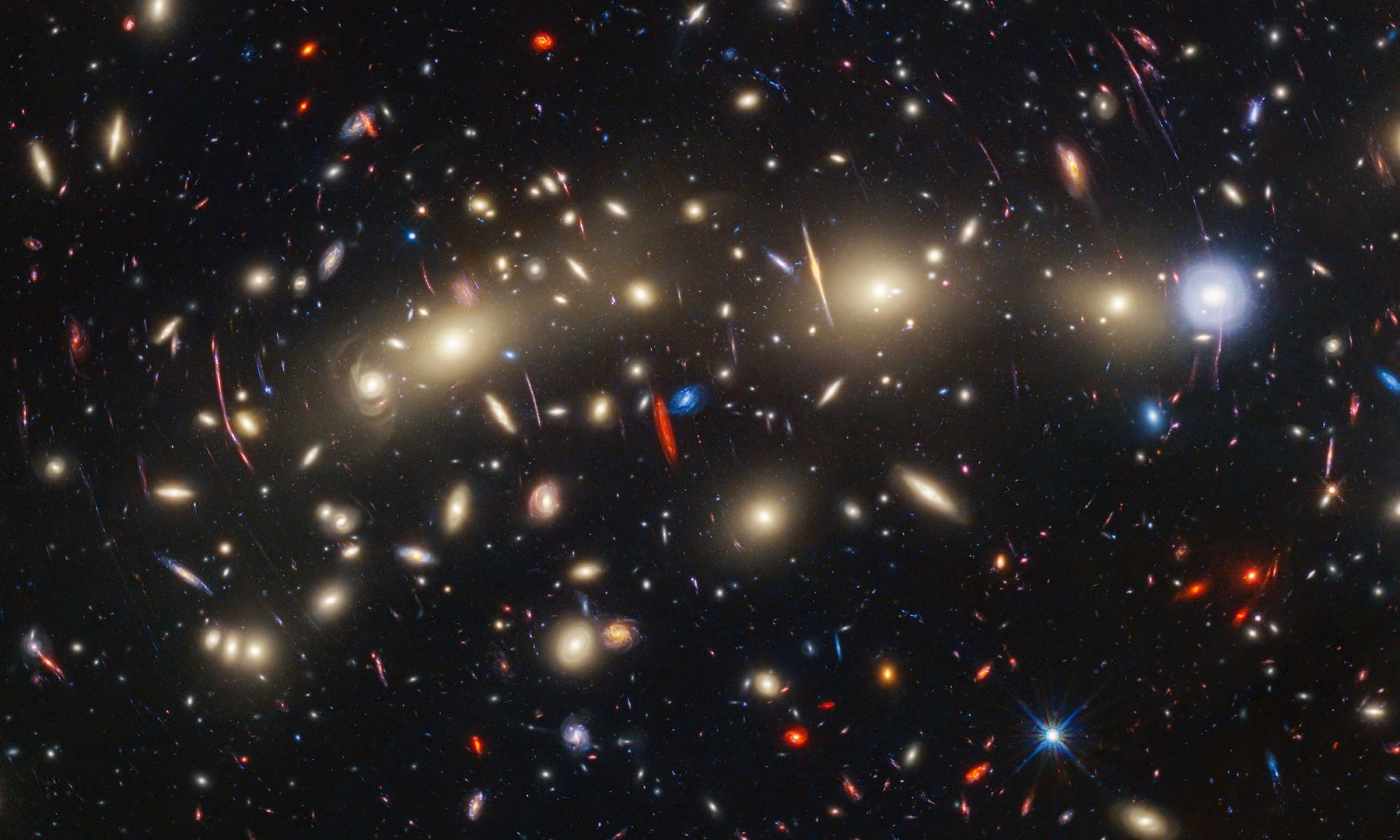In 2012, as part of the MAssive Cluster Survey (MACS), the Hubble Space Telescope (HST) discovered a pair of colliding galaxy clusters (MACS0416) that will eventually combine to form an even bigger cluster. Located about 4.3 billion light-years from Earth, the MACS0416 cluster contains multiple gravitational lenses that allow astronomers to look back in time and view galaxies as they appeared when the Universe was young. In a new collaboration that symbolizes the passing of the torch, the venerable Hubble and the James Webb Space Telescope (JWST) teamed up to conduct an extremely detailed study of MACS0416.
This cluster was the first in a series of super-deep views commissioned in 2014 as part of the unprecedented Frontier Fields program. This collaboration relied on massive clusters of galaxies to conduct gravitational lensing studies, a phenomenon originally predicted by Einstein’s Theory of General Relativity. Based on how the gravitational force of massive objects will alter the curvature of spacetime around them, this program relied on galaxy clusters in the foreground to magnify light from fainter, more distant objects in the background.
The images taken by Hubble of MACS0416 were released in 2014 and used in the Cluster Lensing And Supernova survey with Hubble (CLASH) to help scientists view the early Universe and map the distribution of Dark Matter. Along with the other super-deep field views acquired by the Frontier Fields program, these images provided astronomers with the deepest views of the Universe ever. It also established Hubble as a pioneer mission in the search for fainter, more distant galaxies that existed during the early Universe (ca. 1 billion years after the Big Bang).

One of the many objectives of the JWST is to use its cutting-edge infrared instruments to build on this foundation and provide an even deeper look into the early Universe. Combining Hubble‘s powerful optics with Webb‘s infrared imaging, the two space telescopes produced a composite image that presents the best of both observatories. The combined visible and infrared light – which ranges from 0.4 to 5 microns in the near-infrared (NIR) spectrum – is one of the most comprehensive views of the Universe ever obtained and reveals a wealth of details.
This includes a multitude of galaxies outside the cluster and distant sources that vary in distance (and time). To illustrate the distances, the shortest wavelengths are color-coded in blue, the longest wavelengths in red, and the intermediate wavelengths in green. The blue galaxies were best detected by Hubble, and many showed intense star formation, while the redder galaxies were best represented by Webb. Some galaxies also appear very red because they contain lots of cosmic dust that absorbs light in the blue end of the spectrum.
Beyond the aesthetics, the image reveals several objects that vary in brightness over time (aka. transient objects), which was the purpose of the campaign. To locate these objects in MACS0416, the team used three epochs of observations obtained as part of the Prime Extragalactic Areas for Reionization and Lensing Science (PEARLS) program – Guaranteed Time Observation (GTO) program 1176. The purpose of this program was to study the epoch of galaxy assembly and active galactic nucleus (AGN) growth in the early Universe and included observations of seven gravitationally lensing clusters, taken weeks apart.
These were combined with additional observations by the CAnadian NIRISS Unbiased Cluster Survey (CANUCS) research team. This yielded 14 transients across the entire field of view, twelve located within three highly-magnified galaxies, likely to be individual stars or multiple-star systems. The remaining two transients are within more moderately magnified background galaxies and are likely to be supernovae. One object stood out above all, a star system located that was magnified by a factor of at least 4000 in a galaxy that existed about 3 billion years after the Big Bang.

The team nicknamed this star system “Mothra,” partly because of its extremely bright and magnified nature, but also to go with another lensed star the team previously identified and nicknamed “Godzilla.” Mothra was also visible in the Hubble observations obtained in 2014, which is surprising given that such powerful lensing effects are due to chance alignments between a foreground galaxy and a background star. The team theorizes that this is due to an additional lensing object in the foreground (possibly a star cluster), which they estimate to be between 10,000 and 1 million Solar masses.
Nevertheless, the fact that the team could find so many transients from observations taken within a relatively short time suggests that many more could be found in this and other clusters. This will be possible through regular monitoring with Webb as it continues its ten-year planned mission (with possible extensions to twenty). The Hubble mission, meanwhile, has been in continuous operation for thirty years and shows no signs of slowing down!
Further Reading: ESA

